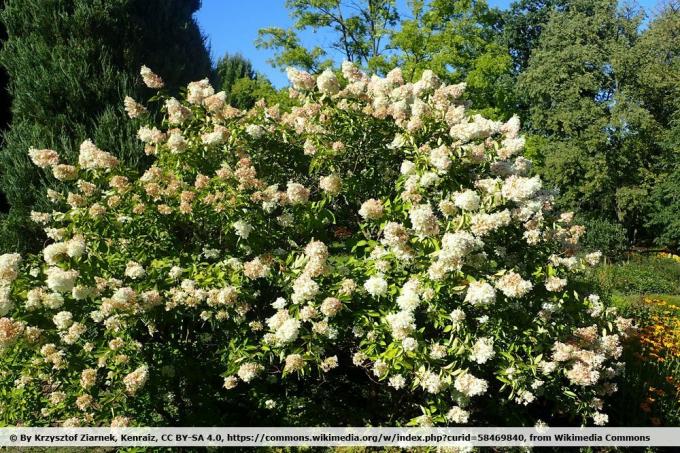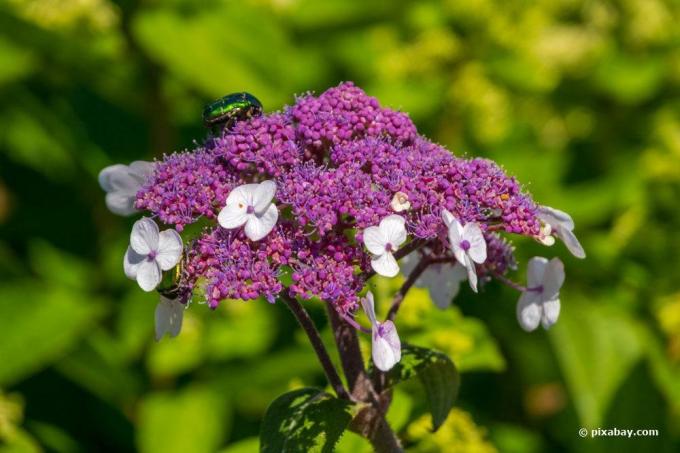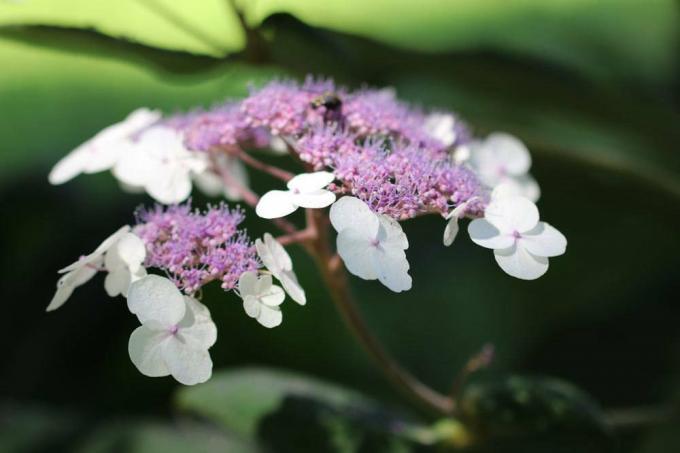
table of contents
- Are all hydrangeas hardy?
- Hibernate hydrangea properly
- Wintering of container plants
- Winter hardy hydrangea varieties
- Farm hydrangea (H. macrophylla)
- Panicle hydrangea (H. paniculata)
- Snowball hydrangea (H. arborescens)
- Velvet Hydrangea (H. sargentiana)
- Climbing hydrangea (H. petiolaris)
- Hydrangea (H. serrata)
The garden classic has been cultivated for centuries. With their impressive flowers and eye-catching leaf color in autumn, the romantic garden beauties set special accents in every garden. With proper care, hydrangeas grow into splendid semi-shrubs. They are suitable for cultivation in the bed, but also as a container plant on the balcony and terrace. The garden perennials are considered to be very robust. Often, however, the question arises: Are hydrangeas also winter hardy? Below are some remarks on this.
Are all hydrangeas hardy?
More or less all cultivated hydrangeas are hardy. However, it is always advisable to provide the plants with light winter protection during prolonged periods of frost. Hydrangeas are subshrubs. The fresh shoots only lignify at their base. These can freeze back in very cold winters. Sometimes just a few nights with temperatures below - 20 ° C are enough. They can also do cold east winds
Flowers destroy quickly for the following year. However, it is not a problem if hydrangeas freeze back heavily above ground, because they keep sprouting from below. They form new shoot buds in the same year. Frozen and dead flower stems can be cut back in early spring when frosts are no longer to be expected.Hydrangea varieties require special winter protection in particularly cold regions of the country, for example in the low mountain ranges or in eastern Germany.
Hibernate hydrangea properly
It always makes sense to also provide hardy shrubs such as hydrangeas with light winter protection. It should be noted
- no fertilization more from late summer
- Shoots must mature by winter
- Cut out dried up and too long shoots
- thereby avoidance of snow breakage
- otherwise no further cutback
- pour properly
- Avoid waterlogging
- root damage makes plants more susceptible to frost damage
If the temperatures then permanently drop below zero, winter protection should be used:
- Spread bark mulch or leaves around plants
- Layer height 10 cm
- In addition, pile up the root neck with garden soil or compost
- Height about 10 to 20 cm
- Protection of the shoots with a special fleece or linen sack
- then fix with rope
- alternatively use of a wire mesh
- cover this with sticks
When applying winter protection, it must be ensured that the plants can always breathe. Newly planted hydrangea varieties that have not yet spent winter outdoors are generally given winter protection. Farmhouse and plate hydrangeas are usually extremely hardy plants if they are located in partial shade and the soil is very humus-rich. In this case, winter protection is not absolutely necessary. Are relatively winterproof
- Farm hydrangeas
- Climbing hydrangeas
- Panicle hydrangeas
- Quick ball hydrangeas
- Velvet hydrangeas
tip: Foil and other airtight materials are not to be used. Condensation forms underneath and the shoots begin to rot.
In general, shade-loving hydrangeas survive strong frosts relatively well. Hydrangeas, on the other hand, do not tolerate the sun as frost-resistant. Wintering in the house would be appropriate here. They are also very suitable as container plants.
Wintering of container plants
These plants are also grown in large pots. However, they then require a bit more maintenance and need good winter protection, especially if it rains frequently in winter and the temperatures are in the minus range for a long time. When cultivating in a bucket, it is essential to ensure that the pot is large enough. Its diameter should never be less than 30 to 40 cm. Then it is also possible to spend the winter outdoors with appropriate winter protection. Otherwise the hydrangea has to be brought into the house.
- A cold house or an unheated greenhouse would be ideal
- Shades against the winter sun are necessary
- hibernate in the basement if necessary
- optimal temperature 3 to 5 ° C
The metabolic cycle is shut down due to the cold and the lack of daylight. The plants are in a kind of "hibernation", which promotes bud formation. However, scale insects are also in high season.
However, there are a few additional measures that need to be taken when overwintering outdoors:
- Cover the surface of the bucket with a layer of leaves
- Wrap the bucket with several layers of bubble wrap
- then coconut mats or fleece over it
- Overhang 10 cm over the edge of the pot
- Place the bucket on a styrofoam board, insulation board or thick wooden board
- Look for a shady place protected from wind and rain
- ideally in front of a house wall
tip: Even in winter, a hardy hydrangea needs watering, but moderately. The best time is in the morning. Avoid waterlogging.
Winter hardy hydrangea varieties
The genus of the hydrangea has a variety of species. They have their origins in North America and Asia. They are deciduous subshrubs with a more or less conspicuous autumn foliage. They eventually shed their leaves in winter. As a rule, the plants are all hardy. There are also particularly winter-hardy hydrangea varieties.
Farm hydrangea (H. macrophylla)
It is originally from Japan. The pseudo-flowers are sterile and do not serve to reproduce seeds. The imposing inflorescences are spherical or flat like a plate. The color varies between white, pink and red. The flowers are already planted in the previous year, in autumn. The growth height is 100 to 150 cm and the growth width 100 to 130 cm. Depending on the variety, the flowers appear from June / July to September. With aluminum fertilization, pink and red flowers can change their color to blue or purple
Endless summer
- ball-shaped inflorescences
- very willing to flower and remounting
- fresh flowers until the first frost
- Blue and pink colors
- Flowering from May to October
- blooms on old and new wood
- Shape cutting possible
- dense, compact growth
- Growth height 100 to 150 cm
- Spread 80 to 100
- Sun to partial shade
- winterproof
- good container plant

Kanmara
- ball-shaped, large inflorescences
- Colors: delicate watercolor tones, pink, rose, rose, champagne, white, lilac
- Flowering June to September
- deep dark green foliage
- very compact growth
- Growth height 100 to 150 cm
- good container plant
- hardy
Forever & ever
- smaller ball-shaped flowers
- but many inflorescences
- remounting variety
- Colors: blue, pink, red, white
- Flowering period June to September
- large, dark green leaves
- quite bushy, compact growth
- Height 70 to 90 cm
- winter hardy variety
- Use as a cut flower
Panicle hydrangea (H. paniculata)
As the name suggests, the inflorescences are panicle-shaped and lilac-like. They appear on annual wood. The color varies between white and cream. It changes to pink or red as it blooms. The flowers give off a delicate fragrance. Depending on the variety, they can reach a height of up to 300 cm. The breadth growth is similar. this hydrangea therefore needs sufficient space. She is quite fast growing. A pruning can be done in autumn or spring before budding. A strong topiary can encourage compact and highly branched growth
Grandiflora
- most common variety
- quite large, conical panicles
- reach length up to 30 cm
- Colors white and pink
- Color change at Wither to pink
- Flowering period June to September
- extremely vigorous
- upright, loose, branching growing
- Foliage leaves pale green, oval
- Height 200 to 250 cm
- Width 175 to 250 cm
- Support of the flowering shoots necessary
- Sun and partial shade
- insect friendly

phantom
- imposing large panicles
- somewhat compressed in length
- Colors: white, cream-white, pink
- Flowering from August to October
- upright, compact growth
- Height 250 cm
- Width 150 to 240 cm
- regular pruning advisable
- Sun and partial shade

Limelight
- Panicles up to 30 cm in length
- Color white to light yellow
- fragrant
- Flowers are suitable for drying
- Flowering July to October
- strong, upright growth
- Growth height 150 to 200 cm
- Spread 160 to 180 cm
- Foliage leaves up to 15 cm in size
- lanceolate-oval with serrated edge
- Sun and partial shade
Snowball hydrangea (H. arborescens)
There are also hardy varieties among these hydrangeas. The flowers are very large, heavy and snowball-shaped. They appear in a variety. The shoots droop due to the weight of the flowers. A support is advisable. The flowering period extends from June to September. The hydrangea, also known as the forest hydrangea, is very robust and hardy. You love partial shade. A regular cut is recommended. The multiplication takes place by division. Runners are formed. The growth height varies up to 300 cm.
Annabell
- most popular variety
- large umbel-shaped flowers
- reach a diameter of up to 25 cm
- Color: white, cream
- Flower balls initially green
- changes to white as it fades
- fragrant
- Flowering period June to September
- Foliage leaves medium green, oval
- many basic instincts
- upright growth
- Growth height up to 200 cm
- Spread up to 180 cm
- Cut back in spring
- good adaptation to different lighting conditions

Hayes starbust
- newer breed
- star-shaped, very filigree pseudo-flowers
- Flowers double
- Color: cream-white with a greenish tinge
- vigorously growing
- Growth height 50 to 120 cm
- Flowering period June to September
Velvet Hydrangea (H. sargentiana)
The hydrangea owes its name to the velvety hairs of its leaves. It is also known as the fur hydrangea. It can reach a height of 200 cm. The flowers are flat umbels with a diameter of 10 to 30 cm. The pseudo-flowers are colored white and the fertile flowers are purple, blue or pink. They give off a honey-like scent and thus attract bees. The hardy hydrangeas love partial shade.
Mauvette
- plate-shaped flowers
- Color: white outside, mauve inside
- Flowering July to August
- dark green foliage
- Growth height 200 cm
- Spread up to 200 cm

Macrophylla
- Flower umbels with a diameter of up to 25 cm
- outer petals pink to white
- inner petals red, pink
- Flowering July to August
- little branched, growing upright
- Foliage leaves up to 35 cm tall, dark green, hairy
- Growth height 200 to 350 cm
- Spread 175 to 300 cm
- Penumbra
Climbing hydrangea (H. petiolaris)
This hydrangea is characterized by its climbing habit. The marginal, white pseudo-flowers are plate-shaped. The flowers are created in the early autumn. They reach a diameter of up to 20 cm and give off a sweet scent of elderberry and jasmine. Bees and bumblebees are welcome guests to these hardy hydrangeas. The summer foliage is shiny green. The leaves turn yellow towards autumn. It adheres to substrates with adhesive roots. Shady north and west walls can be greened.
Seminola
- simple, white flowers
- Flowering June to August
- Height 250 to 300 cm
- Width 100 to 150 cm
- evergreen
- Leaves are shed in cold regions
- copper-red young shoots
- regular pruning in spring
- Bee pasture
- Can also be used as a ground cover
Hydrangea (H. serrata)
The inflorescences are large and plate-shaped. Mostly they appear two-colored, white, pink or red. Often only a wreath surrounds the fertile inner flowers. The buds of these hardy hydrangeas are planted in the early autumn. The hydrangea has a compact habit, but is rather small. It reaches a height of 100 cm. This plant is very easy to care for and extremely hardy. A cut is not absolutely necessary.
Lanarth White
- pure white marginal flowers
- Internal flowers pink
- Flowers larger than 10 cm
- Flowers flat and tightly closed
- Flowering period July to September
- dense bushy growth
- Height 90 to 100 cm
- just as wide
- Leaves green, lanceolate, tapering to a point
- loves penumbra
- do not cut
- Remove dry things regularly
- very easy to care for and hardy
- good container plant

Bluebird
- red-purple to purple-colored inner flowers
- blue stamens
- Color of marginal florets depending on the nature of the soil
- Spectrum from purple, violet-white to blue
- loose, bushy growth
- Growth height 100 to 150 cm
- Spread 100 to 125
- Flowering period July to October
- sunny to partially shaded
- do not cut
- Leaves tinged with reddish tones







